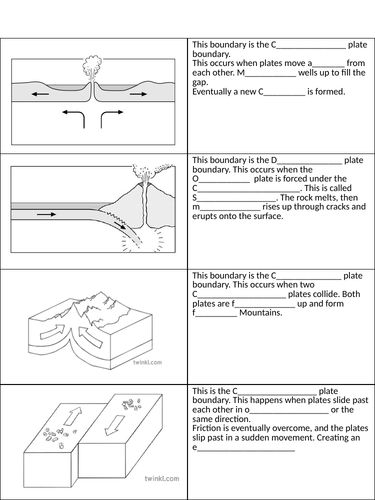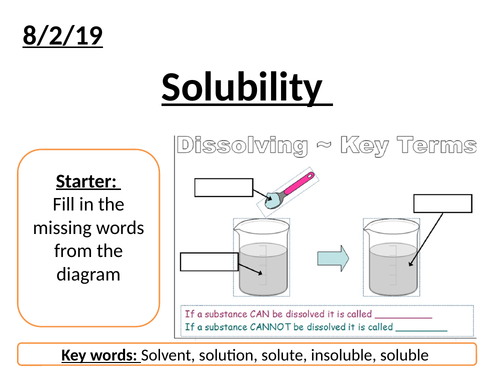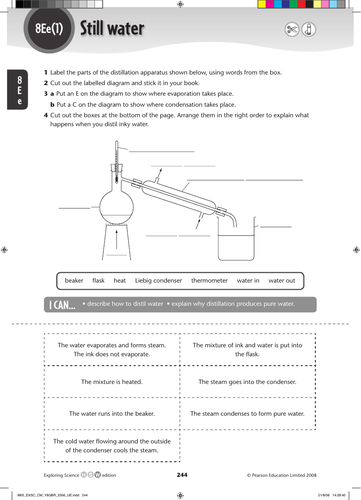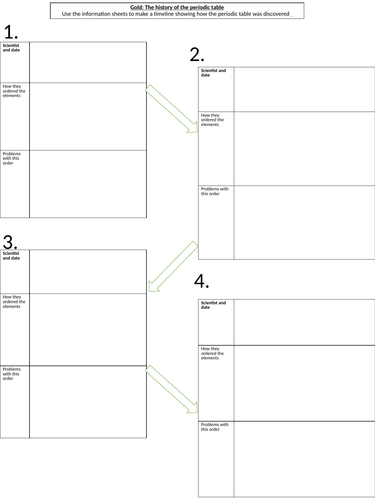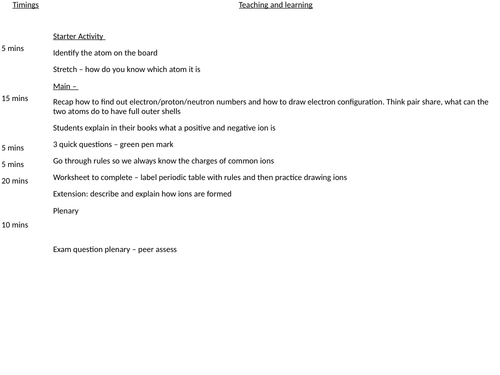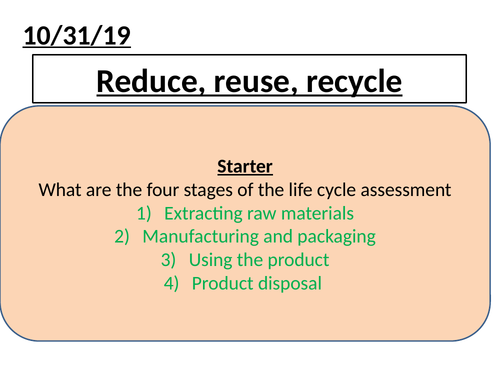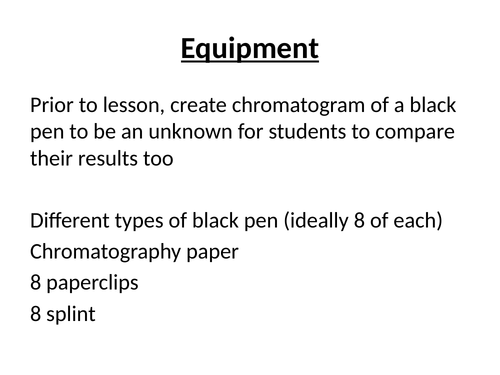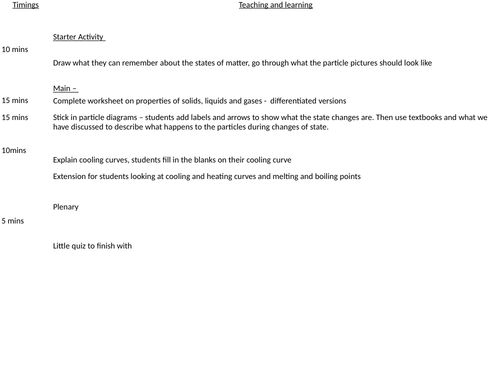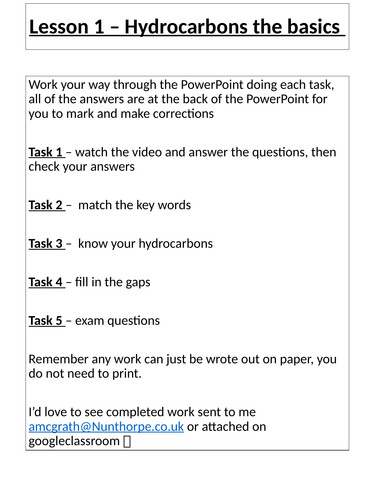
123Uploads
27k+Views
8k+Downloads
Chemistry

Plate boundaries - differentiated tasks
Low ability - fill in the gaps activity with the first letter of each missing word
Middle ability - fill in the gaps
High ability - explain themselves

Dissolving KS3
Aimed at mixed ability year 8 class
Starter: Add key terms to diagram, using key words for the lesson
Main: Define key words and explain solubility
Practical: see if different compounds are soluble or not
Then draw particle pictures of what happens when a substance is dissolving
Plenary: Tweet one thing students learnt today

Simple Distillation KS3
Aimed at mixed ability year 8 class
Starter: would you drink dirty water, how do you think you could clean it?
Main: SMSC link to how many people dont have clean water, fill in SMSC grid based on video
Explain simple distillaation and equiptment, label diagram of equiptment
Watch distillation demo
Bronze/ Gold task to explain distillation
Extension task available on powerpoint
Plenary: Exam question

Potable water differentiated worksheet
Bronze/silver/gold differentiated worksheets
To show how potable water is made
Aimed at low ability students

Pure and Impure
Suitable for KS3
Includes:
Recall starter
Pure and impure including particle diagrams
Pure and impure boiling points
practical investigation to investigate purity

C3.3 Ionic bonding - foundation
Aimed at a lower ability class
Starter Activity
Ions recap, what charge do elements have in different groups
Stretch question to think about how group 1 and 2 will interact with group 6 and 7
Main –
Go through the video and answer the questions, go through answers
Practice drawing ionic compounds Extension: explain the difference between KBr and K2O
Go through the answers which are on the slides
Exam question practice to move onto if have a chance
Plenary
4 mark exam question – peer assess
Good to show the detail they need in their answers

C1.1 atoms
Aimed at a mixed ability year 9 class. Some worksheet from other areas on TES
Starter
Stick in objective sheets for this topic, also stick in common formulae sheets
6 true or false questions – green pen mark
Main –
Think, pair, share – what is an atom? Share ideas, write a sentence to explain what an atoms is. Extension task to label an atoms (level 6 objective) but there is a lesson on the structure of the atom later in this topic
Copy definitions for element/compound/mixture onto worksheet. Then cut up pictures and decide if they are a compound element of mixture
Extension: find the element to spell the cartoon characters worksheet
Identify atoms/elements and name formula worksheet - green pen mark
Extension: write the name of the formulae
Plenary
Whiteboards out, write down the symbol for the elements I shout

History of the periodic table KS3
Differentiated retrieval starter questions.
Go through answers
Main –
Add periodic table to key words, watch video about history of periodic table
Using differentiated sheets, create timeline of history of the periodic table
Label modern periodic table and answer questions
Plenary
Carton elements – identify the carton character

C3.2 atoms into ions - Foundation
aimed at a lower ability class
Starter Activity
Identify the atom on the board
Stretch – how do you know which atom it is
Main –
Recap how to find out electron/proton/neutron numbers and how to draw electron configuration. Think pair share, what can the two atoms do to have full outer shells
Students explain in their books what a positive and negative ion is
3 quick questions – green pen mark
Go through rules so we always know the charges of common ions
Worksheet to complete – label periodic table with rules and then practice drawing ions
Extension: describe and explain how ions are formed
Plenary
Exam question plenary – peer assess

C11.3 greenhouse gases
Aimed at foundation students, targets of level 4
Starter: differentiated bronze/silver/gold starter questions with answers
Main:
Draw the greenhouse effect using info from powerpoint. extension question to challenge students
Fact hunt: questions to answer using textbook
Video on deforestation, questions to answer from video
Plenary: animated true/false statements

C11.5 atmospheric pollutants
aimed at foundation level 4 targets
Differentiated bronze/silver/gold starter
Main: recap complete and incomplete combustion, put piece of pot over blue/yellow flame on bunsen burner
Students fill in worksheet, to say what they saw and the difference between incomplete and complete combustion
Students fill in information grid using textbooks, to find the causes of the atmospheric pollutants and the problems with them
Answers for students to check their answers with
Bundle

C11 - The earths atmosphere
All resources aimed at foundation students
C11.1 + C11.2 combined into one lesson
C11.3 greenhouse gases
C11.4 global climate change
C11.5 atmospheric pollutants

C12.6 reduce reuse recycle
Aimed at low ability students, targets of level 4s
Starter: recap on stages of LCA
Main: link up key words to defintions for three R’s
Pictures on board of different items, what are they made of ? can they be recycled?
Discuss three R’s with students
using textbooks students then make an information sheet using the success criteria on the powerpoint
Plenary: 6 mark question about the the three r’s

Chromatography KS3
Aimed at a mixed ability year 8 class
Starter: summaries what separation techniques students have learnt about so far
Main: Define and explain chromatography
Show students a chromatogram and discuss what we can learn from it
Practical: carry out an investigation to see who wrote the note, work sheet to complete whilst chromatogram is developing
Extension: What effect does each mistake make
Plenary: Exam question

C1.6 structure of the atom
aimed at a mixed ability year 9 class
Starter Activity
Put atom structures in the correct order thinking back to last lesson
Main –
Work through work sheet in steps. To ensure maximum understanding
Chase the element – race task to find out what each element around the room is, identifying proton neutron and electron number and matching it with an element on the periodic table
Make a model of an atom using string, and card (cut card into circles use string to attach them together)
Plenary
Tweet what you’ve learnt tday

C3.1 States of matter - Foundation
Aimed at a foundation class
Starter Activity
Draw what they can remember about the states of matter, go through what the particle pictures should look like
Main –
Complete worksheet on properties of solids, liquids and gases - differentiated versions
Stick in particle diagrams – students add labels and arrows to show what the state changes are. Then use textbooks and what we have discussed to describe what happens to the particles during changes of state.
Explain cooling curves, students fill in the blanks on their cooling curve
Extension for students looking at cooling and heating curves and melting and boiling points
Plenary
Little quiz to finish with

C3.5 covalent bonding - foundation
aimed at a lower ability class
Starter Activity
Mark homework
Main –
Think pair share – spot the difference between ionic and covalent bonding. Then write down definition of covalent bonding
Watch video, only watch until 2 minutes. Answer questions whilst video is going. Goo through and green pen answers after
Go through the two examples on the board and show what happens
Students then have a go at completing their worksheet to show covalent bonds
Extension: decide if the compounds are ionic or covalent and explain how they know
Plenary
Plenary, fill in the gaps and go over answers

C3.4 Giant ionic structures - foundation
aimed at a lower ability class
Starter Activity
Using previous knowledge make predictions about ionic compounds
Main –
Go through and discuss giant ionic lattices
Students move around the room to find the information sheet to find out if there prediction was correct or not and why
Practical with a dissolved ionic compound to show it can conduct electricity. Make sure say that molten ionic compounds too and what a molten ionic compound is
Plenary
Exam question plenary

